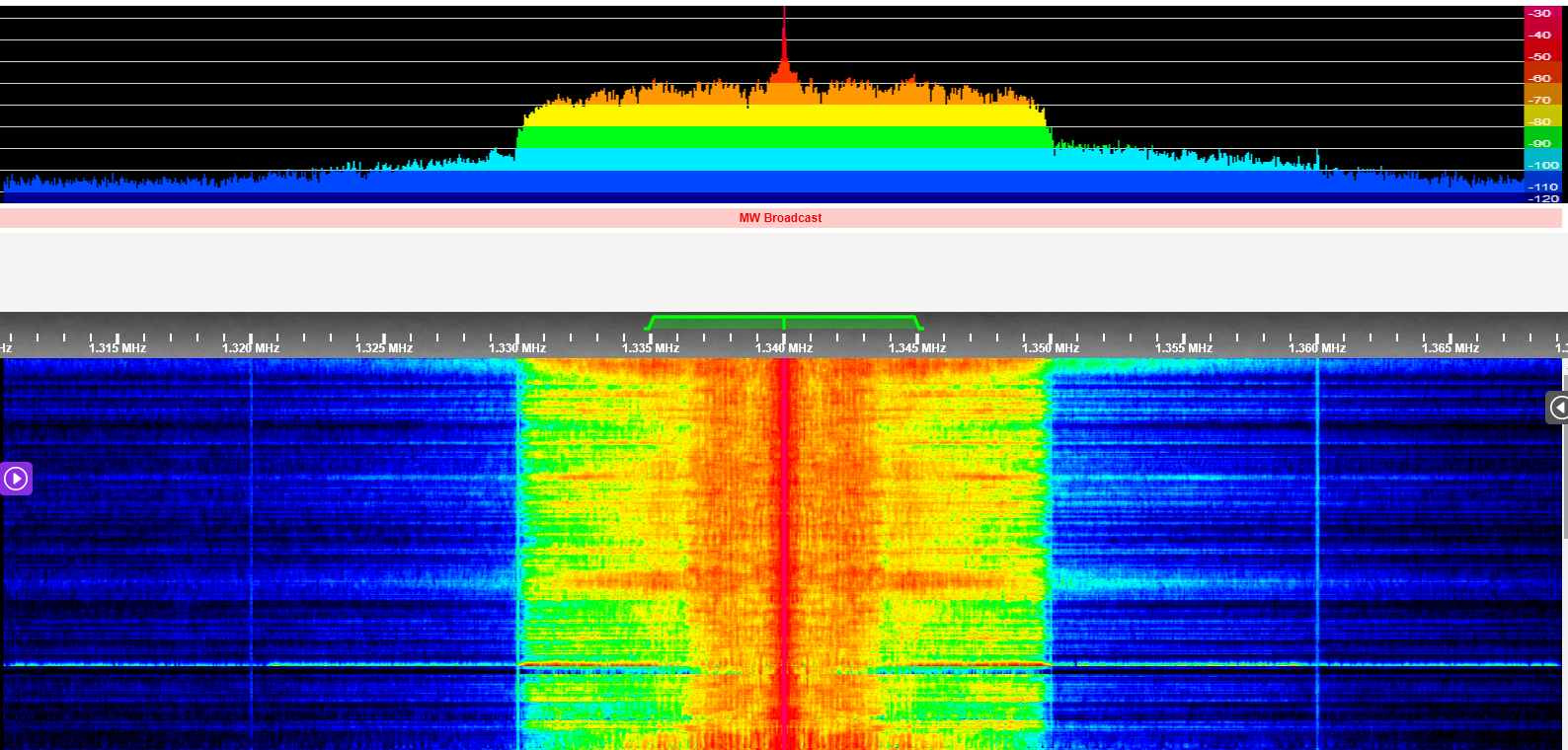Strong broadcast station bandwidth
Purely a curiosity question about bandwidth on a VERY strong AM broadcast station signal. I have a local AM station on 1340 kHz which is around -19 dBm strength, i.e. just below the overload point for the ADC. As the waterfall illustrates, there is a sharp cutoff at the the standard +/- 10 kHz points. But there are still some visible "remnants beyond that during the audio peaks, at much lower strength. I've always wondered if those weak "tails" are actually present in the incoming signal, or is it just a limitation of the FFT on such a powerful signal, close to the ADC overload point? Even if it is truly part of the raw signal, I'm sure it would fully comply broadcast regulations, given the decades lower strength versus the carrier.

Comments
ADC OV Composite signal strength may be a factor, how many other big sigs are you receiving?
Don't assume compliance!
Is your kiwi public?
At 100% modulation instantaneous power is very likely pushing the Kiwi into OV, if your calibrations are correct. This happens at around -15 dBm. An easy test is to insert 6 dB of external attenuation and see if the artifacts go away.. I suspect that they may.
I see this on many strong Broadcast Stations, especially those using a lot of audio compression and processing such as Rock stations. The transmitter will regenerate the side-bands if pushed hard enough, due to a combination of factors such as the production of in-band IMD and clipping.
Here's one UK example which is only peaking -60db but the skirts can be seen at -30dB
http://websdr.uk:8060/?f=1215.000amz9
These are still visible if I switch 10dB of attenuation in circuit, proving that it's not an overload problem.
You can see a similar effect on this screen grab of the same station (received at my home location) using an Airspy HF discovery.
The skirts are only about 25dB down on the band limited modulated sidebands.
Most regulators have a 'spectrum mask' which broadcasters are supposed to comply with in order to prevent interference to adjacent stations. However these days station inspections tend to be few and far between, and unless someone (usually the competition) complains, no one pays any attention.
I was a TV and Radio broadcast engineer back in the day, when the LOUDNESS war's between commercial stations started kicking off here in the UK.
You wouldn't believe how many stations were trying to turn the volume up well past 11 :-)
Regards,
Martin
The AM broadcast spectrum is not terribly cluttered, with just one other strong local at about -30 dBm. At present I am using about 8 dB attenuation to suppress OV indicator flashes - although I suppose the time constant in that would overlook instantaneous overloads. It would be very simple to insert a broadcast filter, but I am leaning toward keeping all the bands accessible; I can accept the 8 dB loss for general listening purposes. It's not public yet, hope to do that in the next couple of weeks.
Adding additional attenuation such as 20 dB does not have much of an impact on the "tails" that spill over beyond 10 kHz, i.e. relative to the main carrier they are about same dB down, so it is "real" in a mathematical, FFT sense. Again, purely my curiosity to understand if it is real in a physical sense - i.e. originating from the transmitter. Not an issue whatsoever, and the same effect can probably be observed on public Kiwis out there with a very strong broadcast signal.
I have MWBC notch filters on all my kiwi systems and if you look at jimlill.com:8073 in the evening, you'd never know there were filters. Without them, I have OV ~100% of the time.
Martin,
I was composing my last reply at the same time you posted those details about broadcast station bandwidth. Thank you, that is EXACTLY what I was looking for! All makes good sense.
73,
Bruce
Also, while zoomed in on strong AM signals like that (a single one or several) bring up the waterfall extension and change the FFT window function. You should see a significant change in the FFT spectral leakage outside of the signal passband. Google "FFT spectral leakage" to understand the tradeoff that is occurring with our friend the FFT..
Those spurious emissions have a spectral density of about -70dBc (with respect to the carrier). It would be great if amateur emissions were this clean. Especially since amateur power levels are reaching the same order of magnitude nowadays. What a shame.
As suggested above, just insert a small attenuator and see if carrier and side noise decrease of the same amount: if they do, the kiwi is measuring correctly, if not, it's hardware intermod or software FFT side effects as John suggested.
marco